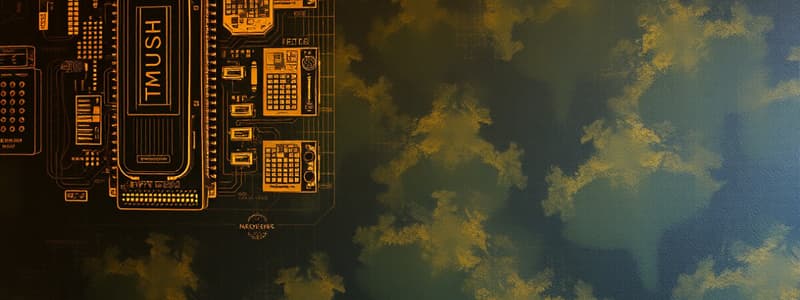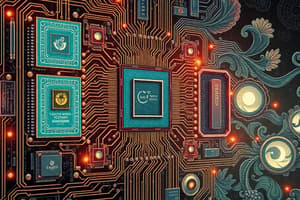Podcast
Questions and Answers
What is the primary function of an operating system?
What is the primary function of an operating system?
- To manage hardware resources (correct)
- To write software applications
- To convert high-level language to machine language
- To provide cloud computing services
Which of the following is a characteristic of high-level programming languages?
Which of the following is a characteristic of high-level programming languages?
- Human-readable syntax (correct)
- Tied to specific hardware
- Directly executable by the CPU
- Requires extensive memory management
What distinguishes primary memory from secondary memory?
What distinguishes primary memory from secondary memory?
- Secondary memory is accessed faster than primary memory
- Primary memory is slower than secondary memory
- Primary memory is volatile while secondary memory is non-volatile (correct)
- Primary memory can store larger amounts of data than secondary memory
What does a flowchart represent in algorithm design?
What does a flowchart represent in algorithm design?
Which encoding scheme supports a broader range of characters than ASCII?
Which encoding scheme supports a broader range of characters than ASCII?
Which of the following best defines artificial intelligence?
Which of the following best defines artificial intelligence?
Which programming construct allows for decision-making in a program?
Which programming construct allows for decision-making in a program?
What is the role of device drivers in a computer system?
What is the role of device drivers in a computer system?
What is the purpose of control structures in programming?
What is the purpose of control structures in programming?
Which of the following best describes a dictionary in programming?
Which of the following best describes a dictionary in programming?
What does the 'break' statement do within a loop?
What does the 'break' statement do within a loop?
How does a 'for' loop differ from a 'while' loop?
How does a 'for' loop differ from a 'while' loop?
Which statement correctly describes the importance of functions in programming?
Which statement correctly describes the importance of functions in programming?
What is meant by 'mutability' in the context of data structures?
What is meant by 'mutability' in the context of data structures?
Which of these is a key feature of strings in programming?
Which of these is a key feature of strings in programming?
What does the term 'digital footprint' refer to?
What does the term 'digital footprint' refer to?
Flashcards are hidden until you start studying
Study Notes
Central Processing Unit (CPU) and I/O Devices
- CPU is the brain of the computer, responsible for processing instructions.
- Input/Output (I/O) devices allow the computer to communicate with the outside world (e.g., keyboard, mouse, printer).
- Evolution of computers has progressed from large mainframes to personal computers and mobile devices.
Data and Information
- Data refers to raw facts and figures; information is processed data that is meaningful.
- Types of data include text, numbers, images, and sounds.
Functional Components of a Computer System
- Main components include CPU, memory, storage, input devices, and output devices.
- Interconnections between components allow them to communicate and function together.
Computer Memory
- Memory is categorized as primary (RAM), cache, and secondary (hard drives, SSDs).
- Units of memory are measured in bytes (KB, MB, GB).
Microprocessor
- A microprocessor is a compact integrated circuit that performs the functions of a CPU.
- Evolution from simple processors to multi-core and high-speed processors.
Software
- Software is a collection of programs that instruct the computer on what to do.
- Types:
- System software manages hardware and system resources (e.g., operating systems).
- Application software serves specific user tasks (e.g., word processors, games).
- Language translators convert high-level programming languages into machine code.
Classification of Programming Languages
- High-Level languages are user-friendly and resemble human languages (e.g., Python, Java).
- Machine language consists of binary code that the computer can directly execute.
Operating System (OS)
- An OS is essential for managing computer hardware and software resources.
- Functions of an OS include process management, memory management, and file management.
Important Terminology
- Encoding: Converting data into a specific format.
- ASCII and UNICODE are encoding schemes for representing text characters.
- Number systems include Decimal, Binary, Octal, and Hexadecimal.
Number Systems
- Decimal is base 10, Binary is base 2, Octal is base 8, and Hexadecimal is base 16.
- Conversion involves changing a number from one system to another.
Artificial Intelligence and Emerging Technologies
- AI enables machines to simulate human intelligence.
- Machine learning is a subset of AI, allowing systems to learn from data.
- Natural Language Processing (NLP) enables computers to understand human language.
- Robotics involves designing machines that can perform tasks autonomously.
- Big Data refers to large, complex data sets that require advanced processing methods.
- IoT connects everyday devices to the internet for smarter functionality.
- Sensors are devices that detect and respond to environmental changes.
- Smart Cities use technology to enhance urban living.
- Cloud Computing allows storage and access of data over the internet.
- Grid Computing uses a network of computers to work on shared tasks.
- Blockchain technology provides secure, decentralized record-keeping.
- 5G Network offers faster internet connectivity and lower latency.
- E-Commerce involves online buying and selling of goods and services.
Problem Solving
- The problem-solving cycle consists of analyzing the problem, designing algorithms, coding, and testing solutions.
- An algorithm is a step-by-step procedure for solving a problem.
- Flowcharts visually represent algorithms and processes.
Programming Constructs
- Constructs include sequence (step-by-step execution), selection (conditional branching), and iteration (repetition).
- Common selection statements are if, if-else, and nested if.
Introduction to Python
- Python is a popular programming language known for its simplicity and versatility.
- Welcomes both interactive mode (user inputs commands directly) and script mode (running complete programs).
- Basic elements include identifiers, keywords, constants, variables, and data types.
Control Structures
- Control structures dictate the flow of execution.
- Sequencing executes statements linearly, selection decides paths, and repetition loops through code.
Functions
- Functions are reusable pieces of code that perform specific tasks.
- User-defined functions are created by the programmer, while built-in functions are provided by the language.
Strings and Lists
- Strings are sequences of characters, with operations for initialization and access.
- Lists store multiple items and allow for manipulation such as creation, initialization, and traversal.
Tuples and Dictionaries
- Tuples are immutable sequences, meaning they cannot be changed after creation.
- Dictionaries store data in key-value pairs, making data retrieval efficient.
Digital Footprints and Cyber Safety
- Digital footprints are traces left by users online, requiring responsible online behavior.
- IPR protects creators' rights, while cyber laws address online crimes like hacking and phishing.
- Cyberbullying is a serious issue that can have real-world consequences.
Impact on Health
- Prolonged technology use can lead to health issues such as eye strain and physical inactivity.
- Awareness and moderation are essential for healthy technology usage.
Studying That Suits You
Use AI to generate personalized quizzes and flashcards to suit your learning preferences.




